
Beyond Orange: Exploring the Colorful World of Butterfly Weed Varieties
Published: 08/07/2024 | Updated: 08/07/2024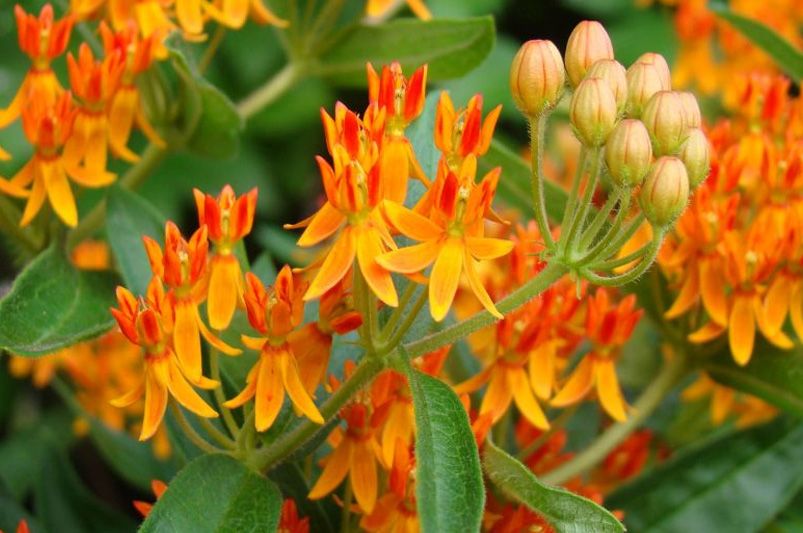
Butterfly weed, scientifically known as Asclepias tuberosa, is a beloved perennial wildflower native to North America. It gets its common name from its remarkable ability to attract and sustain butterfly populations, particularly the iconic monarch butterfly. As a member of the milkweed family, butterfly weed serves as an essential host plant for monarch caterpillars, providing them with the necessary sustenance to complete their life cycle.


Beyond its ecological significance, butterfly weed boasts vibrant, intricate flower clusters that add a burst of color to any garden setting. While the traditional orange variety is widely recognized, this versatile plant offers a diverse array of hues and color combinations, ranging from sunny yellows to deep reds and even bi-colors. Exploring the world of butterfly weed varieties opens up a realm of possibilities for gardeners seeking to create visually stunning landscapes while supporting local pollinator populations.
The Traditional Orange Variety
The classic orange butterfly weed (Asclepias tuberosa) is the variety most people are familiar with. Its vibrant orange umbels bloom from early summer through fall, bringing a burst of warm color to gardens across its native range in eastern and southwestern North America. The flowers emerge atop upright stems clothed in lance-shaped green leaves. This drought-tolerant plant thrives in full sun and well-drained soils, tolerating poor, dry conditions once established. Its nectar-rich blooms are an important food source for adult monarch butterflies, while the leaves provide essential food for developing caterpillars. Beyond its ornamental appeal, orange butterfly weed plays a vital ecological role by supporting these beloved insects and other pollinators.
Butterflyweed
The butterfly weed also known as (Asclepias tuberosa) is a vibrant and hardy perennial known for its brilliant orange blooms that attract a plethora of pollinators, especially butterflies. This North American native is not only a magnet for wildlife but an exquisite addition to your garden.
Plantation & Growth
Thriving in USDA zones 3 through 9, Butterflyweed demands full sun and well-draining soil to flourish. It is well-suited to poor, dry, or sandy soils, reflecting its tenacity and low-maintenance nature. This plant typically reaches a height of 1 to 2.5 feet with a similar spread. It has a deep taproot, making it drought-resistant once established but also tricky to transplant. Plant your Butterflyweed in spring or fall, allowing it to establish its root system without the stress of high summer heat.
Plant Care
Butterflyweed is a champion of self-sufficiency, needing minimal care once settled in its location. Overwatering can be more detrimental than neglect, so water sparingly, allowing the soil to dry out between watering sessions. Fertilization is often unnecessary as Butterflyweed flourishes in lean soil, which can encourage more abundant blooming.
Pruning & Propagation
Pruning is typically not required, though deadheading can promote a second flowering in the same season. To propagate, collect the seed pods in the fall once they start to dry and open. Seeds can be directly sown outdoors in the fall or stratified indoors and planted in spring.
Common Pests & Diseases
Fiercely resistant to most pests and diseases, Butterflyweed occasionally faces issues with aphids and milkweed bugs. These can usually be managed by natural predators or a strong stream of water to knock the pests off the plant. Root rot can occur in wet soils, so ensure proper drainage when planting.
Incorporate Butterflyweed into your garden for a low-maintenance splash of color that supports local wildlife and contributes to a healthy ecosystem.
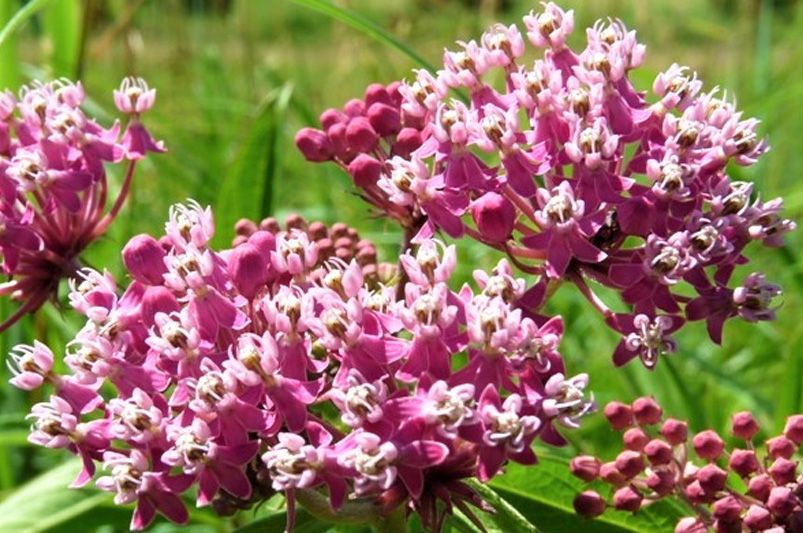
Swamp milkweed
Swamp Milkweed, Asclepias incarnata, stands as a beacon of elegance and an ecological powerhouse in any garden setting. This attractive perennial is famed not only for its beautiful pink and mauve flowers but also for its vital role in providing habitat and food for butterflies, especially the monarch butterfly.
Plantation & Growth
Ideal for USDA zones 3-9, Swamp Milkweed thrives in full sun to partial shade, showcasing a preference for moist, rich soils, as its name suggests. It's particularly well-suited for rain gardens or areas with wetter soil conditions, reaching heights of 3 to 4 feet and spreading 2 to 3 feet wide. Planting can be done in the spring after the danger of frost passes or in the early fall to allow roots to be established.
Plant Care
Swamp Milkweed is forgiving and requires minimal care once established. Regular watering is essential, especially in dryer conditions, to mimic its natural wetland habitat. However, once established, it demonstrates good drought tolerance due to its deep-root system. Fertilization is generally not necessary; a top dressing of compost in the spring can be sufficient for nutrition.
Pruning & Propagation
Pruning can be done to shape the plant and encourage bushier growth. After flowering, seed pods will form, which can be harvested to propagate new plants once they've dried and opened. For a neater garden appearance in the fall, plants can be cut back to the ground.
Common Pests & Diseases
Though resilient, Swamp Milkweed can occasionally be affected by pests such as aphids, milkweed bugs, and spider mites. A strong water spray can dislodge pests, and planting nectar-rich flowers nearby can attract beneficial insects for natural pest control. Root rot can occur in poorly drained soils, so ensure adequate drainage at planting to prevent this issue.
Swamp Milkweed not only enhances the beauty and biodiversity of gardens but also serves as an invaluable resource for pollinators, making it a cherished addition to any garden.
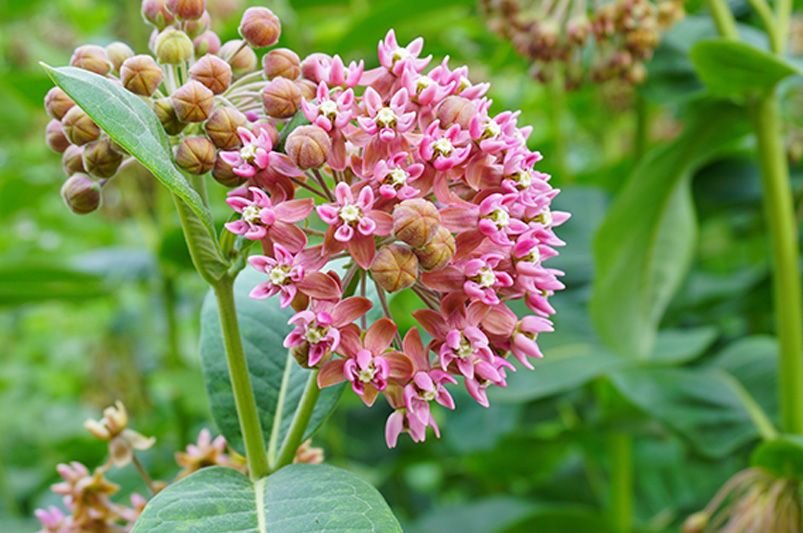
Common milkweed
Common Milkweed (Asclepias syriaca) is the quintessential plant for those looking to attract monarch butterflies and support local ecosystems. Renowned for its fragrant, pinkish-purple flower clusters, this native perennial beautifies the landscape and serves as an integral host for monarch caterpillars.
Plantation & Growth
Adaptable to USDA zones 3 through 9, Common Milkweed prefers a sunny location with well-draining soil, though it will tolerate clay or rocky substrates, showcasing its versatility. Its robust growth allows it to reach heights of up to 5 feet, with a spread of about 3 feet. Sow seeds in the fall to allow for natural stratification or in the spring, after artificially stratifying them in the refrigerator.
Plant Care
Once established, Common Milkweed requires little attention, proving to be drought-tolerant and capable of thriving in poor soil conditions without supplemental fertilization. Watering should be minimal; overwatering can do more harm than good. Their resilience makes them an excellent choice for gardeners seeking low-maintenance plants.
Pruning & Propagation
While not necessary for the plant's health, deadheading spent blooms can make the plant look tidy and may encourage additional flowering. To propagate, allow seed pods to mature and split open, then collect seeds to be planted in the desired location. The deep root system also enables the Milkweed to spread through rhizomes, naturally expanding its presence in your garden.
Common Pests & Diseases
Common Milkweed can attract pests like aphids and the milkweed beetle, but these usually don't require serious intervention. Natural predators often take care of aphid populations. As for diseases, milkweed can be susceptible to root rot in overly wet soil, so proper drainage is critical. Crown rot can also occur if mulch is piled too high against the stems.
Incorporating Common Milkweed into a garden not only adds to the aesthetic but also provides invaluable support to the declining monarch butterfly population and a host of other beneficial insects.
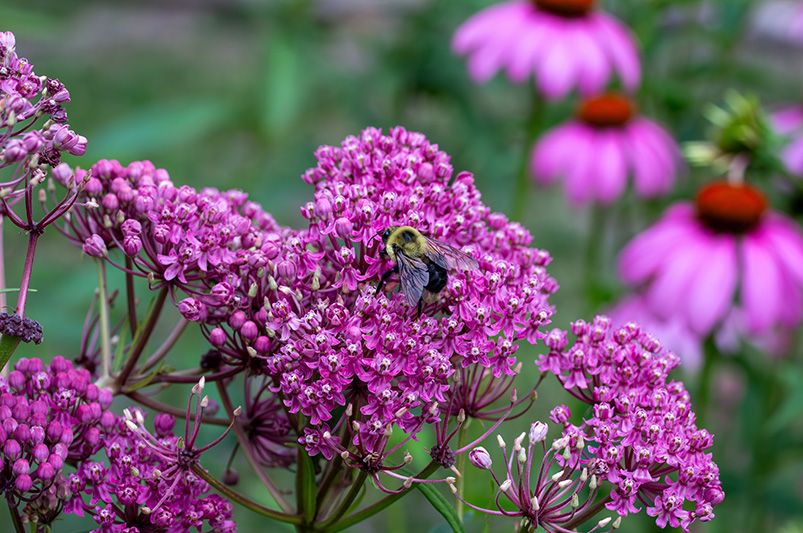
Purple milkweed
Purple Milkweed (Asclepias purpurascens) is a stunning, yet less commonly known native perennial that deserves a spotlight in the garden for its deep purple flowers and its vital role in the monarch butterfly life cycle. This milkweed variant not only offers intricate beauty but also serves as a crucial habitat for pollinators.
Plantation & Growth
Thriving in USDA zones 3-8, Purple Milkweed prefers full to partial sun and moist, well-draining soil. It is more shade-tolerant than many of its milkweed cousins, adding versatility to garden placement. Reaching up to 3 feet in height with a similar spread, its vibrant blooms make it a standout from mid to late summer. Spring is the ideal planting season, allowing roots to be established before winter.
Plant Care
Once established, Purple Milkweed requires modest maintenance. It prefers regular watering, especially in dry periods, to mimic its natural habitat. While it is tolerant of poor soil, a spring application of compost can encourage healthier growth and more vibrant flowering. Avoid over-fertilization to keep growth in check and focus energy on blooming.
Pruning & Propagation
Deadheading spent flowers can promote further blooming and prevent unwanted self-seeding. For propagation, collect seeds in the fall once the pods have dried and opened. Stratification over winter can improve germination rates in the spring. Cuttings can also be rooted in early summer.
Common Pests & Diseases
Purple Milkweed is generally resilient but may occasionally attract aphids. These can be managed with a strong water jet or by encouraging natural predators. It is also susceptible to common milkweed diseases like root rot and powdery mildew in overly wet or poor air-circulation conditions, respectively. Proper spacing and site selection can minimize these issues.
Adding Purple Milkweed to the garden enriches the ecosystem, supporting monarch populations and bringing a splash of royal color to the landscape.
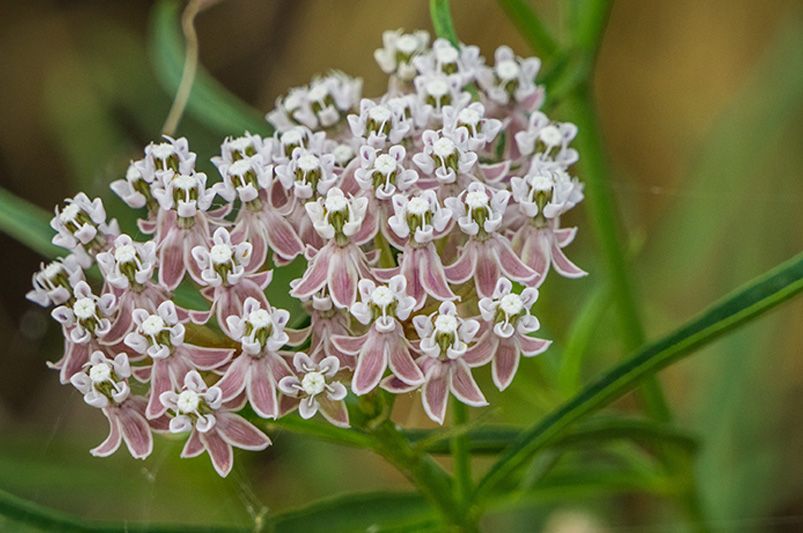
Narrowleaf milkweed
Narrowleaf Milkweed (Asclepias fascicularis), with its elegant, slender leaves and clusters of soft, white to pale pink flowers, is a remarkable addition to any garden aiming to support biodiversity, particularly the treasured monarch butterflies. This resilient species adapts well to various environments, making it an excellent choice for native plant gardens and wildflower meadows.
Plantation & Growth
Adapted to USDA zones 3-9, Narrowleaf Milkweed thrives in full sun to partial shade, preferring well-drained soil conditions. It is moderately drought-tolerant, making it suitable for xeriscaping and low-water gardens. Plant seeds in fall or early winter to allow for natural cold stratification or in spring, after a period of cold, moist storage. Seedlings establish quickly, reaching up to 2-3 feet in height, and start blooming from late spring through summer.
Plant Care
Narrowleaf Milkweed is largely low-maintenance, requiring minimal supplemental watering once established, especially in landscapes that mimic its natural dry habitat. It benefits from a light application of compost in early spring but generally does not need fertilizer. Regular watering in prolonged droughts can help maintain vigor without promoting excessive growth.
Pruning & Propagation
Pruning is seldom needed but deadheading can encourage a second bloom in the late season. Propagation by seeds is straightforward; allow pods to dry on the plant before collecting seeds. For a cleaner garden appearance or to manage spread, cut plants back in late autumn.
Common Pests & Diseases
While relatively tough, Narrowleaf Milkweed can occasionally be affected by aphids and milkweed bugs. These can often be controlled naturally by predators or rinsed away with water. It is less susceptible to diseases than other garden plants, but poor drainage can lead to root rot, so ensure the soil is well-draining at planting time.
Incorporating Narrowleaf Milkweed into your landscape not only enhances its aesthetic appeal but also significantly contributes to the conservation of monarch butterflies and other pollinators.
Bi-color and Multi-color Varieties
While the bright orange of traditional butterfly weed is stunning, some of the most eye-catching cultivars feature a gorgeous blend of colors. The 'Butterfly Weed Mixture' lives up to its name, combining shades of orange, yellow, red, and even white in a vibrant rainbow of hues. Each plant produces clusters of intricately patterned umbels, with no two flowers looking exactly alike.
For a bold, vivid display, consider 'Butterfly Bonanza' - a multi-color variety that showcases brilliant shades of red, orange, and yellow. The contrasting tones create a warm, fiery look that's simply mesmerizing. These bicolored blooms add depth and visual interest to garden beds and borders.
Bi-color cultivars like 'Hello Yellow' and 'Cinderella' pair sunny yellows with deep oranges for a cheerful pop of color. The two-toned umbels create an ombre effect, gradually transitioning from one shade to the next. These versatile varieties complement both cool and warm color schemes in the landscape.
Whether you prefer a harmonious blend or striking contrasts, multi-color butterfly weeds offer a little something for everyone. With their unique patterning and incredible versatility, these cultivars are a fantastic way to add vibrant, long-lasting color to your garden spaces.
Where to Find Unique Butterfly Weed Varieties
While the classic orange butterfly weed is readily available at most nurseries and garden centers, tracking down unique cultivars in different colors can be more of a challenge. Reputable specialty nurseries and seed companies are your best bet for sourcing these less common varieties.
For an impressive selection of butterfly weed cultivars, check out mail-order nurseries like Prairie Nursery, Prairie Moon Nursery, or Shooting Star Nursery. These companies specialize in native plants and often carry hard-to-find seed strains or potted plants. You'll find cultivars like 'Hello Yellow', 'Soulmate', and 'Raspberry Lemonade' in their catalogs.
Local native plant societies or gardening clubs are another great resource. Passionate plant enthusiasts often propagate and share rare varieties through plant swaps or sales. Joining one of these groups can open the door to unique butterfly weed finds in your area.
Online plant retailers and seed exchanges also offer butterfly weed variety packs or seed mixes. Companies like ShrubHub online. Make sure to read descriptions carefully to understand what colors are included.
With some diligent searching, you can curate a collection of eye-catching butterfly weed cultivars to add drama and interest to your pollinator garden. Don't be afraid to ask around at nurseries or connect with other gardeners to get your hands on those special varieties.
Blooming Beyond Orange: A Final Look at Butterfly Weed's Colorful Potential
The world of butterfly weed extends far beyond the familiar bright orange variety. From sunny yellows to fiery reds and even bi-colors, these diverse cultivars offer a kaleidoscope of colors to enliven any garden. More than just ornamental beauties, butterfly weeds are powerhouses for attracting pollinators, supporting biodiversity, and adding vibrant splashes of color.
Whether you're an avid gardener seeking to create a pollinator paradise or simply appreciate nature's vibrant hues, exploring the myriad butterfly weed varieties is a rewarding journey. By incorporating these hardy, low-maintenance plants into your landscape, you'll not only enjoy their stunning blooms but also contribute to the health of local ecosystems. So embrace the colorful world beyond orange, and let the butterfly weed's radiant varieties transform your outdoor spaces into a flourishing oasis for all to admire. Create the landscape you've always desired. Embark on your gardening journey with ShrubHub, where every plant has the power to turn your space into a living masterpiece. Shop now and let the magic begin!


